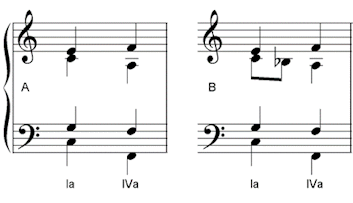Method
In this lesson you will learn my method for tackling Q2 of the ABRSM Grade 7 Music Theory paper. If you can memorise the method, you should find that a chorale question takes no more than about 25 minutes to complete. Here are the steps we’re going to follow.
- Copy each part individually, starting with the soprano, and add unaccented passing notes as you copy.
Copying out a single part in its entirety makes it easier to spot places where passing notes will fit, and also, (crucially!), helps to prevent missed out notes. If you copy out bits in a haphazard manner you may unintentionally miss parts out - Scan the inner parts for places where suspensions will work.
Suspensions make the harmony sound more sophisticated. - Check any printed clues in the B stave.
Printed clues usually direct you to do something in a specific way. - Check momentum.
Is there enough decoration overall, are there any places where you need to maintain/increase momentum? - Make final checks.
Ensure the harmony is all going to work smoothly, and if possible, add some especially sparkly decorations for top marks.
Most of the time, a large percentage of a chorale is quite easy to do. The problems arise with just one or two bars, and these awkward scenarios are often quite different from one exam paper to the next. I’ve covered many of these scenarios individually, and there are some practice exercises you can do to help you spot these tricky corners, so you’ll know how to handle anything that appears.
A final quick word about ABRSM model answers. The answer booklets normally show you exactly what Bach wrote – but your answer might be quite different. I often get asked “how can I know how to write the same as the model answer” – well, you can’t! And you don’t need to, it’s not expected. You just need to write your own answer which is stylish and grammatically correct, that is all.
I strongly recommend that you buy a copy of Bach’s 371 Harmonised Chorales (Riemenschneider edition):
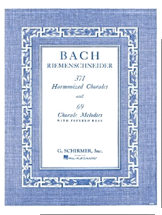
Playing or singing through chorales regularly, either as a whole or voice-by-voice, is the best way to get a grasp on what Bach’s style is, and, perhaps more importantly, what it is not!
Step 1 – Unaccented Passing Notes
The first step is to copy each part (soprano, alto, tenor then bass) one at time, adding unaccented passing notes as you copy.
- Copy the soprano line into stave B. As you are copying, add unaccented passing notes each time the melody moves by a 3rd.
Avoid more than 2 quavers (8th notes) in a row however, in soprano. The soprano line is the tune of the hymn, and should not be overly decorated.
If there are printed decoration notes in stave B which occur at the same time, put an asterisk to come back and check these beats later (See Checking Harmony). - Copy the alto line and add unaccented passing notes between every melodic 3rd. If these passing notes occur at the same time as passing notes in another part, make sure they create harmonic 3rds/6ths (no other interval).
- Copy the tenor line and continue as per alto.
- Copy the bass line and continue as per alto.
- Caution: never put a passing note between the leading note and dominant in V-I. Be vigilant at cadences in particular.
- If you have put passing notes into 3 parts, two parts may end up an octave apart – this is fine. Here is an example; the tenor and bass are an octave apart. The soprano and tenor are a 6th apart, and the soprano and bass are also a 6th apart.

- If you have put passing notes into 2 parts, consider whether adding an auxiliary note into the 3rd part (not soprano) will create a complete chord. This often sounds better than a dissonant decoration.
- Check that none of your passing notes have created augmented 2nds or illegal consecutives. If you have augmented 2nds, you may be able to fix them by raising the 6th degree of the scale. If you cannot fix them, remove them.
Normally you will find that a large proportion of the chorale is now decorated.
Step 2 – Suspensions
After unaccented passing notes, the next most commonly found type of melodic decoration in chorales is the suspension.
To find a place to add a suspension, look for places in the alto and tenor parts where:
- The part moves downwards by step by 2 notes.
- The first note is a 4th or 9th above the bass note of the following chord, which is in root position, or
- The first note is a 7th above the bass note of the following chord, which is in first inversion.
- The resolution note (2nd note) is not doubled in any other upper part (SAT).
In this example, the alto part moves down by step, F-E.
F is a 4th above C. The C is the bass of a root position chord. The resolution note E is not in the soprano or tenor.
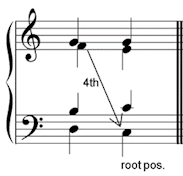
A 4-3 suspension will work. Tie the suspended note back to its preparation.
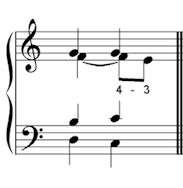
Suspensions can be combined with 7th passing notes at a cadence. In this example, the alto part is decorated with a 4-3 suspension, and the tenor has an unaccented passing note.
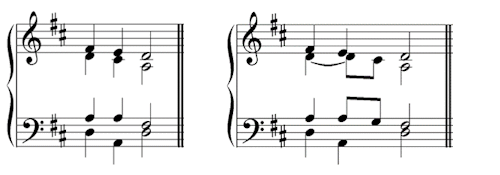
Step 3 – Printed Clues
After adding passing notes, and possibly suspensions if they will fit, next look carefully at any printed notes on the B stave, and try to work out why they are there.
Sometimes notes are given just to fill out the page, so that the question is the right length, but sometimes notes are important clues about what you’re expected to do. It is essential not to ignore any of the printed notes, just in case you miss something vital. The ABRSM’s marking criteria say that “implied features need to be observed”.
In this section, we’ll take a look at some of the implications of the printed clues, but do bear in mind that you might come across a scenario that I have not mentioned here.
Rhythm
One of the easier clues to spot is an implied rhythmic feature. If stave B has semiquavers (16th notes), try to add in some more, but just one or two places will be normally be enough. In fact, a good rule of thumb is to only use semiquavers if you see them as a clue – they are not particularly common in chorales.
Semiquavers usually only occur in one part at a time. They are rarely used together with any other decoration, and they are most likely found in the alto or tenor.
Typically, the rhythm will be a quaver (8th note) and two semiquavers (16ths). Two notes which are a 2nd apart can be decorated with an auxiliary note figure:

This pattern is quite common – here it is in Chorale 172:
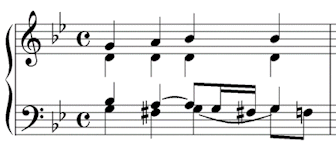
A scale figure with passing notes will fit between two notes that are a 4th apart.

Here is an example from Chorale 131:
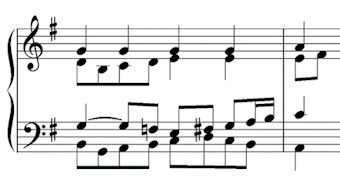
Patterns
Sometimes a stave B clue is a pattern of notes which can be repeated or sequenced, either just before or just after the clue.
In this example, the B stave shows that the repeated bass note Bb is decorated first with a passing note, which then moves to a 1st inversion of the same chord, then drops back down by a 3rd to root position. The next two bass notes are both Cs, and both C major chords, so the same pattern should work here as well.
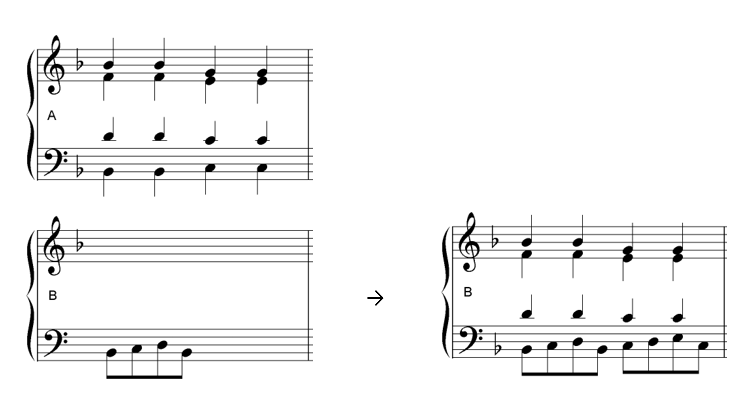
Sometimes a given melodic pattern can be harmonised in 3rds or 6ths in another part. (Notice here that B natural is needed, in order to avoid an augmented 2nd between Bb and C#).
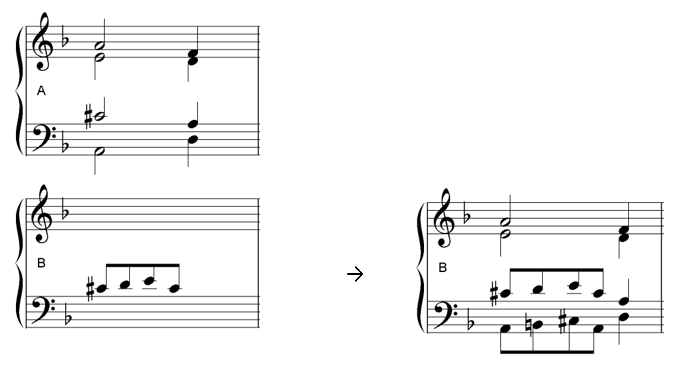
If the printed clue is a decoration which includes an auxiliary harmony note (a different chord note used as decoration), sometimes the reason is that this decoration note creates a preparation for a suspension.
The B stave here has an auxiliary harmony note G. The G allows a 7-6 suspension, resolving to F#.
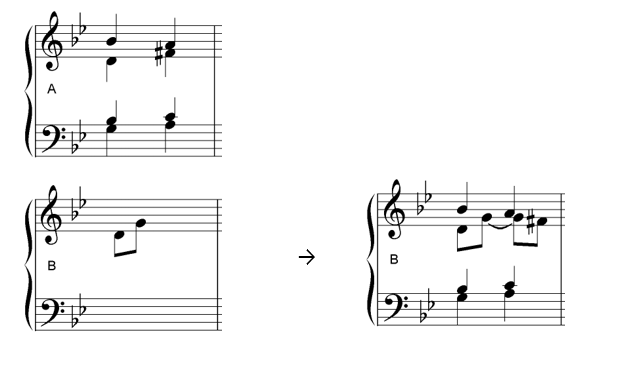
If the bass line moves to or away from the 3rd of the chord, you will need to compensate by adding or removing it in another part. The chord should have its 3rd sounding at all times.
In this example, the bass line moves to D, so the F# needs to be placed into another part as a quaver (8th note). The alto is the best part, because it has the correct voice leading from F# to G.
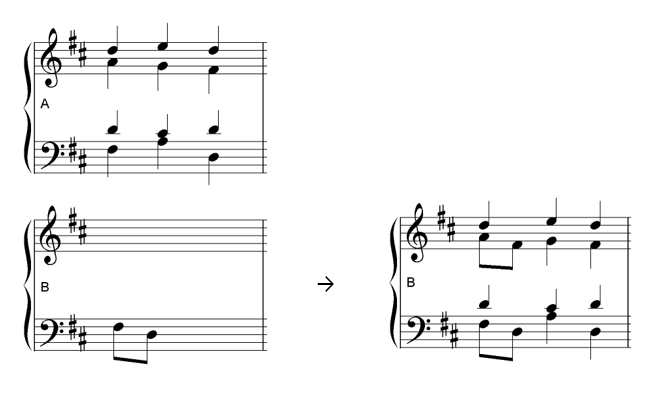
Step 4 – Further Decoration
Aim for a maximum of one undecorated crotchet (quarter note) beat per bar. Three or four beats of the bar should be moving at the speed of a quaver (8th note). There are several ways to keep the rhythm moving. If you have not added much decoration at this stage, or there are places where there is insufficient movement, these suggestions should help.
This section is arranged by note values. Then, the ideas are ordered by melodic interval.So, for example if you are stuck in bar with crotchets (crotchet notes) that all move by an interval of a 2nd, look at “Crotchet Movement – Seconds”.
Crotchets (1/4 Notes)
Unisons:
Auxiliary notes. The auxiliary note should normally be consonant in a new chord. If the auxiliary note creates a “non-chord”, it’s usually better not to use it. Use auxiliary notes very sparingly.
The C auxiliary note does not work so well, because the combined notes G-C-G-Bb do not form a consonant chord. The Eb auxiliary creates a chord of Eb major, so this works better.
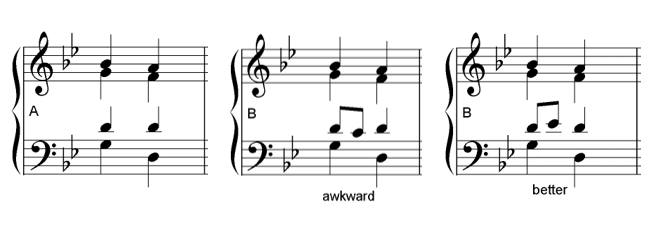
Prolonging the first note by 50%. In this example, the tenor part now moves between the beats instead of on them.
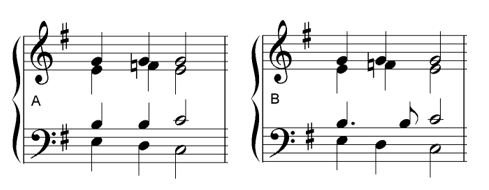
Seconds:
2nds can occasionally be decorated with an auxiliary harmony note. These are most often found in the bass part, and will only normally work if the resulting chord is a root position or 1st inversion (not 2nd inversion). Avoid leaping into a subsequent first inversion chord.

Fourths
4ths can be filled in with two passing notes, one unaccented and the other accented.
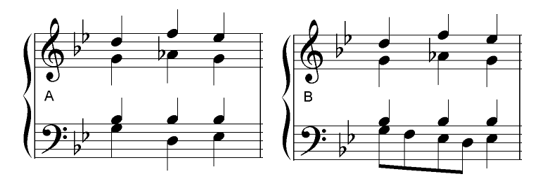
Fifths
5ths are most often only found in the bass. You can sometimes add an auxiliary harmony note.

Minims (Half Notes)
Minims (half notes) are often found at cadences.
Before a paused chord of the same type as the previous, a minim is often not decorated.
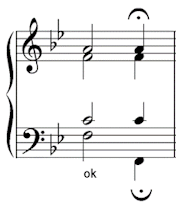
At a perfect cadence, use a steps-up-skip-down note pattern (but not in the soprano).
Here are two ways of decorating this dominant chord (notice the accidentals needed for A major).
Alto: F=passing note, G=auxiliary harmony note (7th), E=melody note.
Tenor: D=passing note, E=auxiliary harmony note, C#=melody note.
Bass: B=passing note, C#=auxiliary harmony note, A=melody note.

At a I-V imperfect cadence (or plagal cadence, but these are rare), fill in the gap in the bass with the notes from the scale:
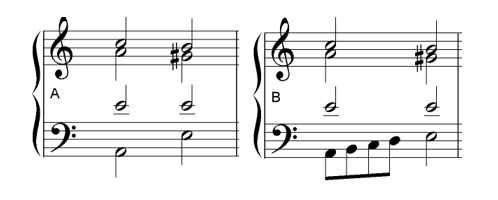
Step 5 – Checking the Harmony
Sometimes the provided harmonic outline and/or printed B part includes problems which you need to solve. Generally, there are three types of issue:
- The printed part includes notes which do not combine into a proper chord.
- The printed part includes untypical voice leading.
- The printed part contains grammatical errors (e.g. consecutive 5ths, poorly placed second inversion chords, untypical progressions, etc.)
You should also check through all the accidentals on the page.
1. Proper Chords
Look at the chord notes which fall on each beat. If the notes don’t “spell” a proper chord, first try to determine the purpose of each note. It is important to avoid multiple dissonances of different types. On-beat dissonances can exist as decoration notes (accented passing notes or suspensions), or as part of a chord (added 7ths or 9ths), but these should not normally be mixed together.
If you find a dissonance “pile-up”, make an alteration so that only one type of dissonance is used. You can either extend the previous note, or add a nearby note (or a combination of these).
In this example, alto and bass parts are provided on the B stave.
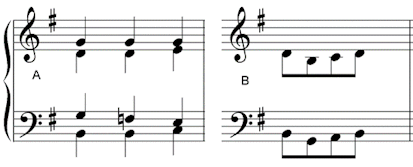
If we simply copy over the remaining soprano and tenor notes, the result is in a jumble of notes on beat 2, that do not combine into a proper chord. The problem is caused by a dissonant 7th (F), in combination with accented passing notes (A and C).
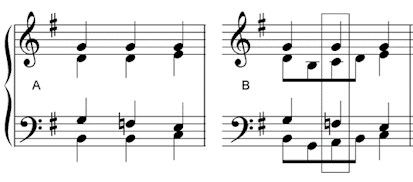
To fix this, we can delay the tenor 7th by extending the G from the first beat. This will transform beat 2 into chord ii7a (A-C-E-G). (Although the ii7 chord has a potentially problematic doubled 7th, this is ok because the tenor note is held rather than repeated, and the chord moves on to V7 (in C major) quickly.)
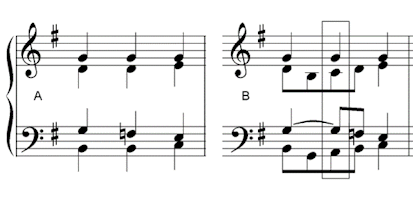
2. Voice Leading
If the harmonic outline includes an awkward interval in the bass line, this should normally be smoothed out with decoration notes. Here, the diminished 4th is filled in.
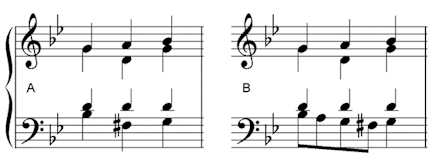
3. Grammatical Errors
If the harmonic outline has consecutives, untypical progressions (including poorly placed second inversions), it will normally be necessary to insert a completely new chord between those two beats. In this example, the stave A has consecutive 5ths.
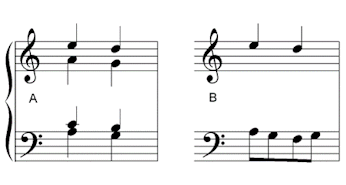
We must create a completely new chord between the 5ths. Prolonging the alto and tenor notes will create a chord of Dm7 (ii7b) on the third quaver, which solves the issue.
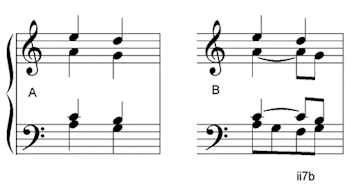
Don’t forget that a second inversion chord may be used as a passing 6/4 on weak beat, but not a strong beat, and the bass must move by step.
Accidentals
It is easy to miss places where accidentals need to be added. Check through carefully, particularly looking for “illegal” augmented 2nds, and accidentals that change during the same bar.
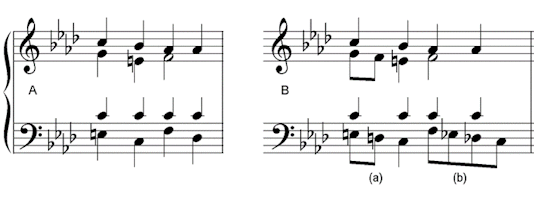
At (a), D natural is necessary to avoid an augmented 2nd from E natural.
At (b), the bass note on beat 4 is Db, so we must use Eb as a passing note before it, not E natural, to avoid the augmented 2nd.
Both the Eb and Db need accidentals, because naturals were used earlier in the bar.
Step 6 – A Step Further
The following ideas may be useful for an added bit of sparkle.
1. Sometimes adding an unaccented passing note would create consecutive 5ths. Instead of avoiding a passing note completely, you could try adding an accented passing note instead.
In this example, adding an unaccented passing note E in the alto would cause consecutive 5ths with the tenor:
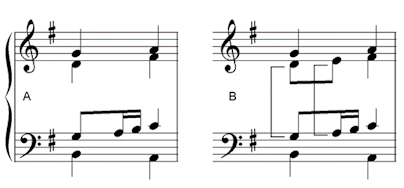
Changing the E to an accented passing note removes the problem. (Notice that this actually results in a new consonant chord (A-C-E) on the 2nd beat of the bar).
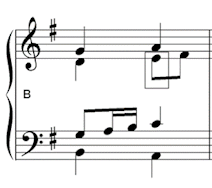
Accented passing notes add momentum on the beat after the passing note, whereas unaccented passing notes create movement on the beat before. Realising this can help you find additional beats to decorate.
Accented passing notes are most often used in a downwards direction and can sound awkward when rising, if they are dissonant with the rest of the chord.
2. Consider whether using a temporary leading note (semitone lower than the root of the next chord) as a decoration note would enhance the progression, particularly at a cadence. This could be as an unaccented chromatic passing note:
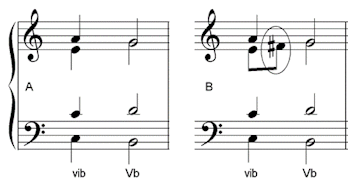
Or as a chromatic auxiliary note:
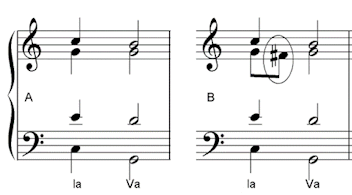
3. In a I-IV progression, you may be able to flatten the leading note of the prevailing key as a passing note. (In C major, flatten the leading note to Bb, moving to A in F major):
